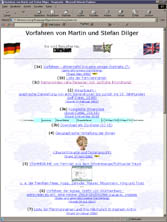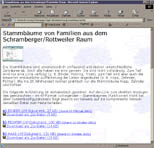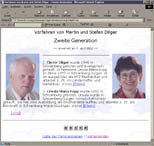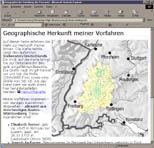Ancestor research in the Black Forest and surroundings.
Since the end of 1999 I (Martin Dilger) am occupied with researching my ancestors. Most of them lived in catholic areas at the eastern edge of the middle Black Forest - in the places Schramberg, Sulgen (today a part of Schramberg), Lauterbach, Tennenbronn, Aichhalden, Hardt and Mariazell (today belonging to the municipality Eschbronn), then, going deeper into the Black Forest, around Triberg (here especially the villages Gremmelsbach and Nußbach), Schonach and Schönwald.
 |
| To the Main Page |
A second center of the origin of my ancestors - especially on my fathers side - forms the Protestant characterized region of Freudenstadt - Baiersbronn - Klosterreichenbach (today part of Baiersbronn) - Dornstetten - Haiterbach - Altensteig.
Again Catholic is the area around Horb, Empfingen and Haigerloch, where the majority of the remaining ancestors of my father originates.
A protestant branch on the side of my maternal ancestors goes into the outskirts of St. Georgen: Langenschiltach, Brigach, Stockburg, Mönchweiler and other.
Partly or not yet researched places are (with others): Rottweil, Elzach, Waldkirch und Vöhrenbach, furthermore Hofstetten near Haslach, Schapbach und Sinzheim (Baden).
The surname ![]() Dilger line I could retrace up to the 16th Century.
Dilger line I could retrace up to the 16th Century.
 |
| Directly to the Pedigrees |
Also on the side of my maternal grandparents I was able to go back to the end of the 16th century. The Thirty Years' War 1618 to 1648, however, forms the beginning of the ![]() church books for a whole set of municipalities, which are particularily interesting for these researches. This is a first bigger obstacle for further researching. For example in Schramberg both baptism-, marriage- and death-books begin with the year 1639, in the neighbor villages Sulgen and Lauterbach some years later. Further back go (among other things) so called Bestands- and Ertragsbücher (stock and yield books, e.g. the
church books for a whole set of municipalities, which are particularily interesting for these researches. This is a first bigger obstacle for further researching. For example in Schramberg both baptism-, marriage- and death-books begin with the year 1639, in the neighbor villages Sulgen and Lauterbach some years later. Further back go (among other things) so called Bestands- and Ertragsbücher (stock and yield books, e.g. the ![]() "Urbar of Rochus Merz" from 1549/58) or official calculation books ("Amtsrechnungen"). The earliest data of not-noble ancestors I have from the first half of the 15th century (e.g. Maurer, Rapp, Seckinger). However, the genealogical linkages I have for this time are at least in some cases speculative due to the quite meager amount of documents.
"Urbar of Rochus Merz" from 1549/58) or official calculation books ("Amtsrechnungen"). The earliest data of not-noble ancestors I have from the first half of the 15th century (e.g. Maurer, Rapp, Seckinger). However, the genealogical linkages I have for this time are at least in some cases speculative due to the quite meager amount of documents.
 |
| Directly to the Ahnentafel |
The situation of the ![]() sources is better in the old wuerttembergian and protestant places north ot the Herrschaft Schramberg. Of a majority of the places of this area church books are still preserved back to the transition from the 16th to the 17th century, partly even back to the year 1558 (so in Reinerzau for example).
sources is better in the old wuerttembergian and protestant places north ot the Herrschaft Schramberg. Of a majority of the places of this area church books are still preserved back to the transition from the 16th to the 17th century, partly even back to the year 1558 (so in Reinerzau for example).
In one place in the Ahnentafel the transition to the aristocracy can be proven. Ludwig Rechberger, born around 1492, was an illegitimate son of Ludwig von Rechberg, the legitimate successor of (the quite famous) Hans von Rechberg on the castle Hohenschramberg. From here it is, with the help of the relevant printed family trees, not very difficult to retrace the line up to Charlemagne. But this is not really very interesting I think... - A small cutout from the Ahnentafel of Hans von Rechberg, i.e. the ancestors of Agnes, countess of Württemberg, died on February the 12th in 1373, can be found on my ![]() aristocracy page.
aristocracy page.
 |
| Directly to the Maps |
In my opinion the research on the basis of the church books and other documents of the last four, five centuries is more exciting and more interesting - primarily due to the, to a certain extent, non-standard note (with Charlemagne finally each European is more or less often related) and the so to speak "pioneer character" of the work (the Ahnentafel of a farmer and a craftsman family in a rural area is simply not as often in printed products than, perhaps, ![]() Heinrich the Lion).
Heinrich the Lion).
Much fun on my pages
Martin Dilger
P.S.: Perhaps the best view you will keep over the whole Family Dilger Site and its data - meanwhile over 300 Pages with about 21 MB of material -, when you make the ![]() Main Page to your starting point.
Main Page to your starting point.
Questions, criticism or other notes you can e-mail me. In particular, if you register linkages with your own Ahnentafel or you assume one or you are doing research in the same areas like me, specified above (whereby at the present especially the region around Schramberg is of great interest for me): don't hesitate to email to me. You are welcome indeed!
Links
www.martin-dilger.de
www.herrschaft-schramberg.de
www.reichsstadt-rottweil.de
www.siliconavatar.de
www.neurostorm.de
www.stefandilger.de
Last updates in summer 2015
© Martin Dilger 2000-2015
www.familie-dilger.de
www.herrschaft-schramberg.de
www.reichsstadt-rottweil.de

![Version française [Google]](_images/flag_fra.gif)